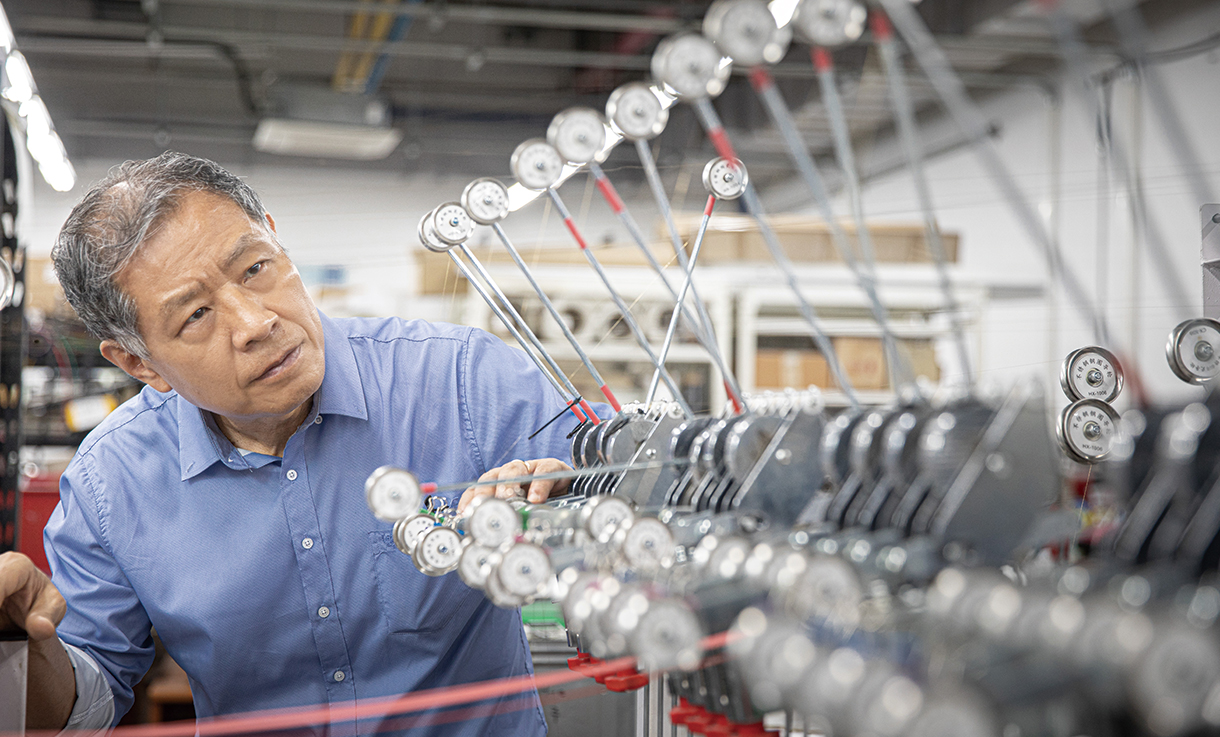

Story
친환경 에너지도 피할 수 없는 폐기물,
지속가능한 소재 기술 개발 서둘러야
Waste Comes Even From Eco-friendly Energy,
The Need for the Development of Sustainable Material Technology
기계공학부 하성규 교수
Prof. Sung Kyu Ha, Division of Mechanical Engineering
- 글 박영임
- 사진 손초원
- Writing Park Yeong-im
- Photograph Son Cho-won
Scroll Down
We only have several more years to save the Earth from the climate crisis. Therefore, many countries are accelerating the development of eco-friendly energy sources such as solar power, wind power, and hydrogen to reduce emissions of greenhouse gases. However, these powergeneration methods and the materials needed for them also generate waste and ultimately damage the environment. Professor Sung Kyu Ha points out that we can realize the true meaning of the development of eco-friendly energy only when generation, transportation, storage facilities, and materials of renewable energy are also renewable.

친환경 에너지의 오점, 폐기물
“기존 화석연료 사용 시 비싼 단가에서 야기되는 경제적인 문제와 환경 문제 등을 극복하기 위해 신재생에너지를 활용하는데, 그 장비와 부품 및 재료가 친환경이 아니다? 그래서 아이러니하게도 그 방법으로 에너지를 만들어내는 데 현재 더 많은 탄소가 배출되고 있다? 과거 10년 전만 해도 신재생에너지 발전에서 대부분 효율만을 최우선으로 생각해, 그 방법이 추후에 야기할 환경 문제 영향은 충분히 고려하지 못했습니다.”
최근 전 세계적으로 20~25년의 수명을 다한 풍력발전기 날개가 쏟아지면서 환경 부하를 가중시키는 데 대해 하성규 교수가 일침을 놓았다. 현재의 친환경 에너지가 중요하듯이 미래의 환경도 중요하다는 지적이다. 지난 30여 년간 섬유와 플라스틱을 합체한 복합재료를 에너지 분야에 적용하는 연구를 펼쳐온 하성규 교수 또한 과거에는 성능을 높이는 데만 주력했다고 밝혔다. 하지만 미래 세대를 위해 지속가능한 연구를 해야 한다는 소명으로 재생가능한 복합재료 개발에 연구를 집중하게 됐다.
“에너지를 필요로 하는 분야 중에서 항공, 차량, 해상 등의 운송이 중요한데, 튼튼하면서 가벼운 복합재료로 제작돼야 에너지 손실을 최소화할 수 있습니다. 에너지를 만들어내는 풍력발전기, 에너지를 저장하는 수소 저장탱크도 마찬가지입니다. 이런 부품과 장비에 적용되는 복합재료 개발 시 그 성능은 유지하면서도 자연 친화적인 부품과 재료의 연구가 활발히 이뤄져야 합니다.”
즉, 탄소섬유 · 유리섬유 복합재료로 제작되는 풍력발전기의 날개나 수소 저장탱크도 이제는 성능뿐 아니라 추후 폐기했을 때 환경오염을 일으키지 않는 친환경 소재로 제작돼야 한다는 것이다. 현재 하성규 교수는 전 세계적으로 친환경 소재(수지)를 공급하는 프랑스의 아케마(Arkema), 인도의 아디트야벌라(Aditya Birla), 대만의 스완코(Swancor)와 각각 재생가능한 복합재료를 개발하고 있다.
Waste, the drawback to eco-friendly energy
“We use renewable energy to solve the economic and environmental problems caused by the high costs when using existing fossil fuels. However, the equipment, parts, and materials are not eco-friendly. Therefore, ironically, more carbon is emitted currently to produce energy this way. Until 10 years ago, efficiency was the top priority in renewable energy generation, while the impact on the environment was not adequately taken into account.”
Professor Ha criticized the recent increase in environmental load in the world due to wind turbine blades that have reached the end of their life at 20 to 25 years. The environment of the future is just as important as the current eco-friendly energy. Professor Ha, who has been conducting research on the application of composite materials of fibers and plastics on energy for the past 30 years, admitted that he had also focused only on improving performance. However, with a sense of responsibility for sustainable research for the future generation, he started focusing on the development of renewable composite materials.
“For the fields that require energy, the most important are air, vehicle, and marine transport. To minimize energy loss, they must be made with strong but lightweight composite materials. The same goes for wind-power generators that produce energy, and hydrogen storage tanks that store energy. When developing composite materials for these parts and equipment, we need to study parts and materials that are nature-friendly, while maintaining their performance.”
In other words, the wind-turbine blades and hydrogen-storage tanks that are made of carbon fiber/glass fiber composite materials, in addition to their performance, must now be made of eco-friendly materials that do not cause environmental pollution when disposed of in the future. Currently, Professor Ha is developing renewable composite materials with Arkema of France, Aditya Birla of India, and Swancor of Taiwan, which supply eco-friendly materials (resin).
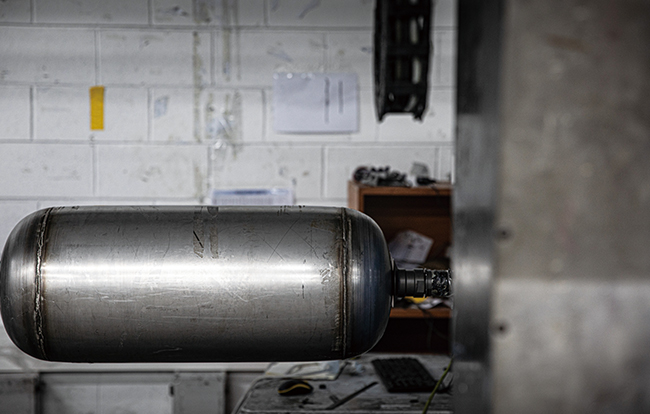
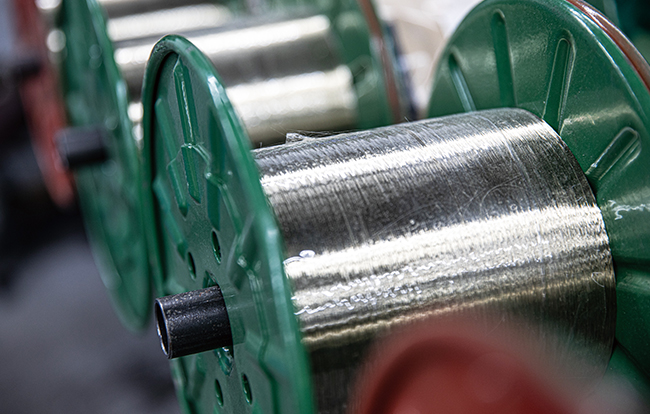
복합재료의 장점에 재생가능성 추가
복합재료의 기능과 재생가능성을 높이려면 재활용 재료에 대한 폭넓은 이해와 설계 및 부품 제작 기술이 필요하다. 하성규 교수 연구팀은 이 분야에서 독보적인 기술로 여러 글로벌 기업과 협업하고 있다.
“우리보다 앞서 풍력발전이 보급된 유럽에서는 이미 폐기물 문제가 심각해 법적 규제에 이른 상황입니다. 그래서 재생가능한 소재 개발을 서둘러야 합니다. 시장의 판도가 바뀌는 중이라 관련 업체들은 시장 선점을 위해 기술 개발에 나섰죠. 어떻게 재료를 조합해야 자연 친화적으로 재생가능하면서도 더 가볍고 우수한 소재를 개발할 것인가, 이는 재료 공급업체뿐 아니라 이를 제품에 적용하는 기업에도 궁극적인 경쟁력이 될 것입니다.”
하성규 교수는 풍력발전기 날개 소재뿐 아니라 궁극의 미래 에너지로 주목받고 있는 수소 에너지 저장 압력용기(수소 저장탱크)도 친환경 기술로 개발하고 있다. 현재의 수소 용기는 풍력발전기 날개와 마찬가지로, 친환경 자동차에 적용됨에도 그 자체는 재활용되지 않는다. 수명이 다하는 15~20년 후에는 폐기물로 버려져야 한다.
“수소 용기 분야에서 아직은 안전성을 추구하는 데 초점이 맞춰져 있어 친환경의 재생가능한 압력용기에 대한 관심은 그리 크지 않은 편입니다. 하지만 수명을 다하게 될 수소 용기 폐기물 대처 방안을 지금부터 미리 고민해야 합니다.”
풍력발전 사례와 같이 수소 압력용기도 향후 법적 규제가 진행될 것이다. 하성규 교수는 우리나라가 세계적으로 수소에너지를 선도하며 초격차 기술을 선점하는 데 친환경 기술이 국가적으로 중요한 전략이 돼야 한다고 강조했다. 가격경쟁력을 갖춘 친환경 수소 저장용기 설계와 제작 기술 상용화를 앞당기기 위해 하성규 교수는 지난 2020년 ‘쓰리피닷컴’이라는 사명으로 창업도 했다. 현재는 직접 생산은 하지 않고 국외 업체에 기술이전 형태로 기술을 제공하고 있다. 올해 4월에도 프랑스 파리에서 열린 JEC(국제복합소재전시회)에 대학 연구팀으로는 유일하게 참가하고, 가격경쟁력을 갖춘 친환경 수소 용기 신제품을 선보이며 업계 관계자들의 관심을 불러 모았다. 재생 소재를 사용할 때 성능이 떨어지는 단점을 혁신적인 설계로 보완하고, 자연 친화적인 수소 저장용기의 여러 가능성을 제시함으로써 재생 소재에 대한 인식을 환기하는 계기가 됐다.
Renewability added to the advantages of composite materials
To improve the functionality and renewability of composite materials, a broad understanding of recyclable materials and component design and manufacturing skills is required. Professor Ha’s research team is currently collaborating with many global companies, using their unique technologies in this field.
“In Europe, where wind-power generation was utilized earlier than in Korea, waste problems are already so serious that they are implementing legal restrictions. Therefore, we need to urgently develop renewable materials. As the market is changing, relevant companies have already started developing technology to possess the market. The ways in which we will combine materials to develop nature-friendly, renewable, and more lightweight and superior materials will become the ultimate competitive edge — not only for material suppliers but also for companies that use such materials in their products.”
Professor Ha is developing wind-turbine blades with eco-friendly technology, as well as pressure containers for hydrogen energy (hydrogen-storage tanks), the ultimate future energy. Existing hydrogen containers, just as with wind turbine blades, are not recyclable, even though they are used for eco-friendly vehicles. After 15 to 20 years when they reach the end of their lifespan, they must be disposed of as waste.
Professor Ha explains, “For hydrogen containers, the focus is still on pursuing safety, and there isn't much interest in eco-friendly and renewable pressure containers. However, we need to think about how to deal with hydrogen-container waste in advance.”
As in the case of wind turbine blades, hydrogen containers will also be subject to legal restrictions in the future. Professor Ha emphasized that eco-friendly technology needs to be a national strategy for Korea to lead the global hydrogen-energy industry and take the lead in developing advanced technology. In order to accelerate the commercialization of design and manufacturing technology for cost-competitive eco-friendly hydrogen storage containers, Professor Ha also started a company in 2020 under the name 3PdotCOM. Currently, the company does not manufacture products themselves, but provides technology to foreign companies in the form of technology transfer. In April this year, they have participated in the JEC World (International Composites Show) in Paris, France, as the only university research team — and drew attention from the industry by demonstrating their new cost-competitive, eco-friendly hydrogen container products. This presented an opportunity to raise awareness of renewable materials by remedying the shortcomings of poor performance in the use of renewable materials with innovative design and presenting various possibilities of environment-friendly hydrogen storage containers.
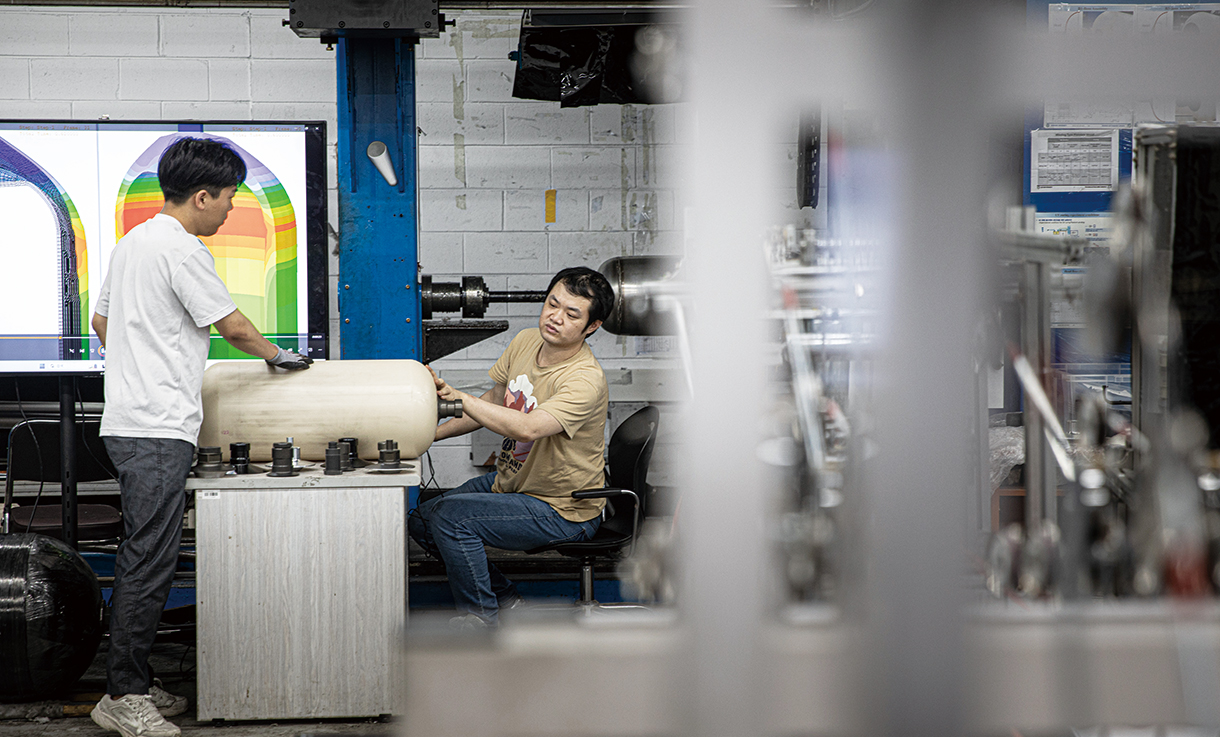
엔지니어링의 기능과 가치에 친환경과 재료의 순환이라는 가치를 추가하고, 시야를 미래로 확장해 지속가능성을 더욱 중요하게 여겨야 한다
We need to add the values of eco-friendliness and recycling of materials to the functions and values of engineering, and broaden our future horizons toward the future and value sustainability more.
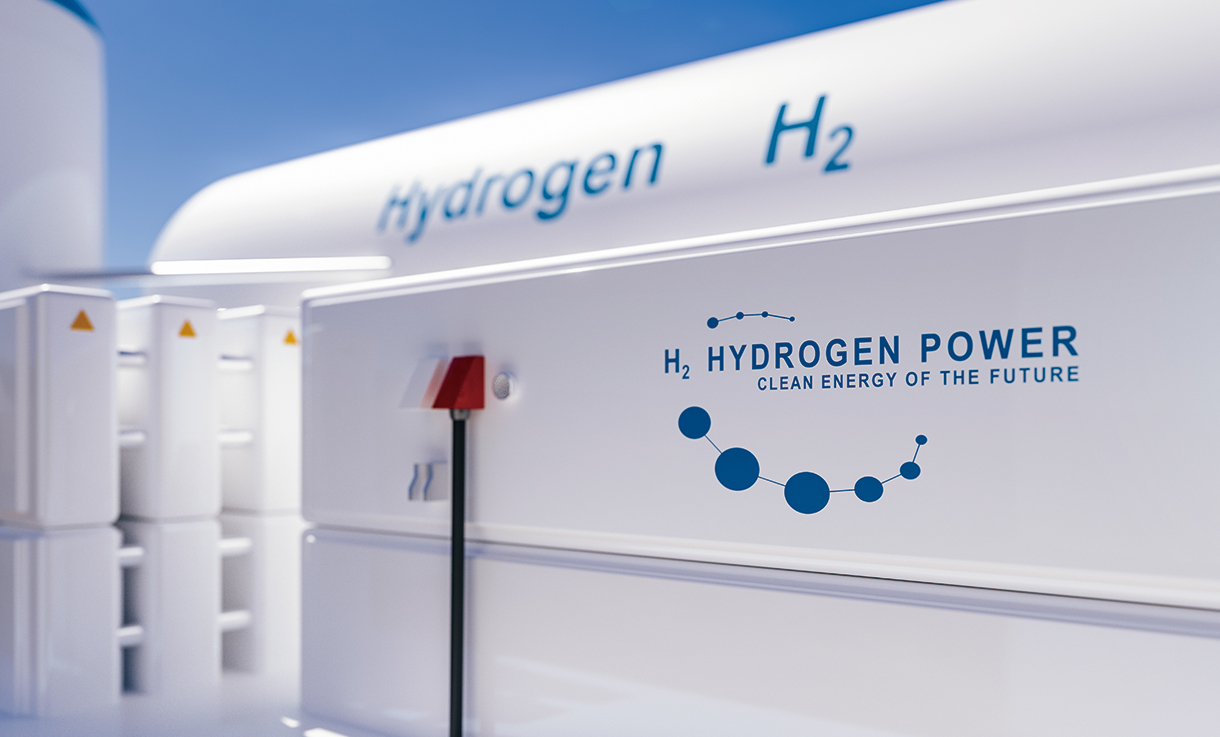
어떤 기술이 인류를 위한 기술인가
하성규 교수는 지난 30년 동안 복합재료를 연구하면서 시뮬레이션에 기반한 설계와 제조공정 개발, 실험을 통한 복합재료의 구조적 성능 평가에 이르는 일련의 과정을 통합적으로 진행할 수 있는 능력을 인정받았다. 국내는 물론 프랑스, 독일, 중국, 인도, 대만, 브라질 등 여러 국가의 산업체와 함께 기술을 개발하고 있다. 하성규 교수는 기술 개발을 의뢰받아 진행하는 것뿐 아니라, 전문가로서 수요와 공급의 흐름을 읽고, 각 기업의 특성에 따라 무슨 기술을 개발해야 하는지 제안하고 선도하는 역할을 수행하는 것도 중요하다고 전했다.
“기술 개발은 우리 인류의 삶을 이해하고 만족시켜야 하지만, 동시에 식욕을 억제하듯이 욕구를 절제해 시대에 따라 변화하는 가치에 대응해야 합니다. 그러기 위해 각국의 전문가 및 산업체와 교류하며 새로운 방향을 제시해야 합니다.”
연구자의 사회적 책임을 깊게 염두에 두고 있다는 것을 짐작하게 하는 발언이다. 하성규 교수가 창업에 도전한 것도 사실 같은 맥락에서 이해할 수 있다. 현재 하성규 교수는 정년을 2년 정도 앞두고 있는데, 그동안의 은퇴 교수의 예를 보면 평생 연구해온 훌륭한 기술 성과와 노하우가 은퇴와 함께 사라지는 경우가 많았다. 평소 이를 안타깝게 여긴 하성규 교수는 그동안 축적한 재생가능한 복합소재 기술 개발이 계속 이어져 산업계에서 잘 쓰일 수 있기를 바라는 마음으로 창업을 추진했다.
“이제는 엔지니어가 추구하는 성능, 편리성, 가격경쟁 확보의 가치에 친환경과 재료의 순환이라는 가치까지 추가해야 합니다. 즉, 기존에는 현재의 우리가 누리는 가치만 추구했지만, 앞으로는 시야를 미래로 확장해 지속가능성의 가치를 중요하게 여겨야 해요. 그러기 위해서는 현재의 기술이 지속가능해야 합니다. 이는 단지 재료가 친환경일 뿐 아니라 얼마나 순환될 수 있는가가 중요하다는 의미입니다.”
자연 친화적인 재생 소재와 이를 제품화하는 새로운 패러다임을 이끌어야 한다는 것이 하성규 교수의 소명이다.
What technology works for humankind
By studying composite materials for the past 30 years, Professor Sung Kyu Ha was recognized for his ability to integrate a series of processes — from design and manufacturing process development based on simulations, to structural performance evaluation of composite materials through experiments. He is currently developing technologies with industries from many countries including France, Germany, China, India, Taiwan, and Brazil, as well as Korea. Professor Ha remarked that it is important to not only receive orders for technology development and proceed with them, but also to identify the flow of supply and demand as an expert, propose what technology to develop according to the characteristics of each company, and to lead the development thereof.
“Technology development must be based on an understanding of human needs, but at the same time, it must control humans' desires, just as we suppress appetite, to respond to the changing values of the times. To do so, we need to propose new directions by communicating with experts and industries of each country.”
We can presume that he is deeply considering the social responsibility of a researcher. Professor Ha’s business startup can be understood in the same context. Currently, he has about two more years until his retirement. Looking at the examples of other retired professors, excellent technology achievements and know-how that has been accumulated during a lifetime of research often disappears with their retirement. Professor Ha feels that this is regrettable, and therefore pushed ahead with the startup — hoping that his accumulated achievements in renewable composite material development will continue and be used in the industry.
He explains further, “Now, we need not only to secure performance, convenience, and cost-competitiveness that engineers have been pursuing, but also to add the values of eco-friendliness and the recycling of materials. In other words, we used to pursue only the values that we could enjoy during the present, but in the future, we need to broaden our horizons to the future and think about sustainability. For this, current technology must be sustainable. This means that not only the materials must be eco-friendly, but consideration should also be given to how much they can be recycled.”
It is Professor Ha’s belief that he needs to lead the development of nature-friendly and renewable materials, and the new paradigms for commercializing them.
